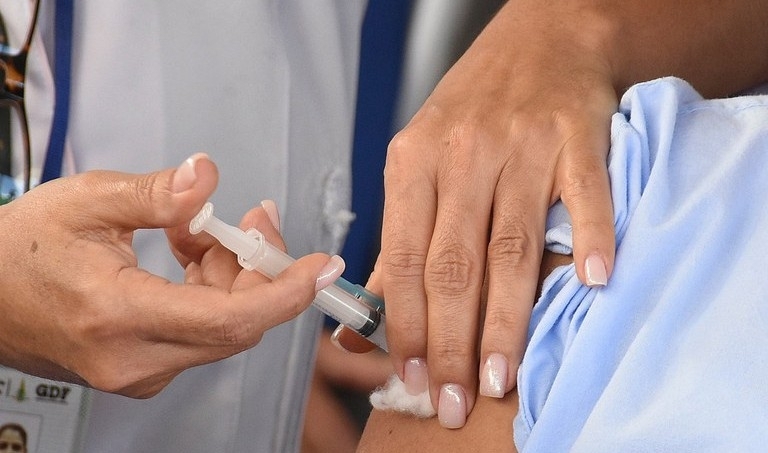

Brazilian researchers measured this increase in immunity in a study involving health workers who had received two doses of CoronaVac. In subjects given the Oxford-AstraZeneca vaccine, the same booster raised immunity by a factor of 7 (photo: Tony Winston/MS)
Brazilian researchers measured this increase in immunity in a study involving health workers who had received two doses of CoronaVac. In subjects given the Oxford-AstraZeneca vaccine, the same booster raised immunity by a factor of 7.
Brazilian researchers measured this increase in immunity in a study involving health workers who had received two doses of CoronaVac. In subjects given the Oxford-AstraZeneca vaccine, the same booster raised immunity by a factor of 7.

Brazilian researchers measured this increase in immunity in a study involving health workers who had received two doses of CoronaVac. In subjects given the Oxford-AstraZeneca vaccine, the same booster raised immunity by a factor of 7 (photo: Tony Winston/MS)
By Luciana Constantino | Agência FAPESP – The drop in immunity from SARS-CoV-2 detected 75 days after two doses of CoronaVac or the Oxford-AstraZeneca vaccine (ChAdOx1) can be significantly reversed by a Pfizer/BioNTech booster, according to a study conducted in Brazil by the Federal University of São Paulo’s Medical School (EPM-UNIFESP).
The study showed that a booster dose of the Pfizer/BioNTech vaccine increased the level of antibodies measured after two doses of CoronaVac by a factor of 25 and after two doses of ChAdOx1 by a factor of 7. The findings are described in an article published in the Journal of Infection.
Supported by FAPESP via two projects (17/20106-9 and 20/08943-5), the study involved a non-randomized cohort of 48 health workers at hospitals and regional institutions with an average age of 30 for subjects given CoronaVac, and 40 for subjects given ChAdOx1.
“We’ve seen that adherence to the booster dose isn’t as high as it could be. However, our study shows its importance insofar as it significantly increases the immune and cellular response, and therefore provides stronger protection,” Alexandre Keiji Tashima, a professor in the Biochemistry Department of EPM-UNIFESP and corresponding author of the article, told Agência FAPESP.
On March 19, booster doses had been given to 34.2% of Brazil’s population, or some 73 million people, and 74% (157 million) had been fully immunized with two doses (or one dose of single-dose vaccines), according to Our World in Data.
“When the pandemic began, we assembled a group of researchers at UNIFESP to conduct biochemical studies relating to COVID-19. Our goal is to produce a complete biochemical characterization of the antibodies,” said Tashima, who is PhD thesis advisor for Jackelinne Yuka Hayashi, first author of the article. Four researchers at the Brazilian subsidiary of Germany’s EUROIMMUN AG, a leading provider of medical laboratory diagnostics, also participated in the study.
The group’s findings corroborate studies already published by scientists at universities from Hong Kong and from the United States.
Other research had demonstrated the effectiveness of the booster. For example, according to an article published in early February in Nature Medicine, the Pfizer/BioNTech booster administered six months after two doses of CoronaVac confers 92.7% protection against infection and 97.3% against severe outcomes. Data for almost 14 million Brazilians were analyzed in this study.
Booster effectiveness
In the UNIFESP study, blood was sampled from participants on five occasions: before vaccination, 28 days after the first dose, 14 days after the second dose, 75 days after the second dose, and 14 days after the third (booster) dose. Clinical tests were performed to detect levels of IgG antibodies against SARS-CoV-2, neutralizing antibodies and cellular responses.
In the group given two doses of CoronaVac and the Pfizer/BioNTech booster, the mean IgG level rose from 19.8 BAU/ml (binding antibody units per milliliter of blood) after the first dose to 429 BAU/ml after the second. IgG values equal to or above 35.2 BAU/ml were considered positive.
The level of protection fell sharply in the next 10 weeks, reaching 115.7 BAU/ml. After the booster dose, however, IgG levels rebounded, rising by a factor of 25 to 2,843 BAU/ml. Levels of neutralizing antibodies rose from 23.5% after the second dose to 99.3% after the booster.
In the group given two doses of ChAdOx1 (Oxford-AstraZeneca) and a Pfizer/BioNTech booster, IgG rose from 86.8 BAU/ml to 648.9 BAU/ml between the first and second doses, declining after that to 390.9 BAU/ml. Then jumped by a factor of 7 to 2,799.2 BAU/ml after the booster. Neutralizing antibodies rose from 63.2% to 98.9%.
“Even with the drop in immunity after the second dose, there may still be a relevant cellular response against the viral antigens, but what’s interesting is that both cellular and humoral [antibody] responses increased strongly after the third dose in both groups. We were struck by this measure of effectiveness, indicating a good response in both groups,” Tashima said.
The authors acknowledge limitations such as the small sample size and age differences between the groups. Some volunteers were infected by the omicron variant after receiving a booster dose. The researchers are now collecting more blood samples from the same subjects to analyze the impact of this variant, which accounted for 97% of confirmed cases of COVID in Brazil in early January.
The article “Humoral and cellular responses to vaccination with homologous CoronaVac or ChAdOx1 and heterologous third dose with BNT162b2” is at: www.journalofinfection.com/article/S0163-4453(22)00115-3/fulltext.
Republish
The Agency FAPESP licenses news via Creative Commons (CC-BY-NC-ND) so that they can be republished free of charge and in a simple way by other digital or printed vehicles. Agência FAPESP must be credited as the source of the content being republished and the name of the reporter (if any) must be attributed. Using the HMTL button below allows compliance with these rules, detailed in Digital Republishing Policy FAPESP.





